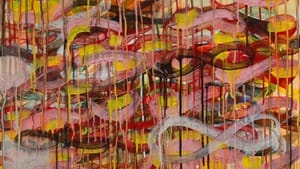Stay in the Loop
BSR publishes on a weekly schedule, with an email newsletter every Wednesday and Thursday morning. There’s no paywall, and subscribing is always free.
The art of healing
Old City Jewish Art Center presents Tremain Smith’s ‘The Art of Grief and What Follows’

“I am a painter of wounds. Revealing the wound invites healing,” writes Tremain Smith in The Art of Grief and What Follows at Old City Jewish Art Center (OCJAC), which presents the artist’s paintings and meditations in the wake of her mother’s 2015 death.
Earlier that year, the contemporary artist relocated from West Philadelphia to Maine to care for Susan Smith. “I could not change what was happening, I could only go on with it,” she writes. Afterward, trying to make sense of the loss, she did what came naturally: putting paint to canvas and pen to paper.
Painting infinity
Painting was almost reflexive as Smith found her way through deep grief. The words usually came later, as she considered the image. Grief Painting #1 (2015) is a field of infinity symbols in black, red, pink, and yellow. The canvas drips with paint, as though shedding tears. Infinity signs appear in many of the works on view, but Smith refers to them as “figure-eights,” which her mother told her to paint “when things got rough.”
“So I did,” Smith writes in one of the poems that accompany the images. “I painted them over and over again. In every color I had…throwing paint, moving my energy.” Expressing the hurt physically enabled her to verbalize what she felt.
Smith, whose works are held in the permanent collection of the Metropolitan Museum of Art, strives to access the spiritual through the visual and devotes considerable time to sharing her approach with students. She holds a teaching artist certificate from the University of the Arts, has developed intergenerational art programs, and has taught in a variety of settings in Philadelphia, including Penn Alexander School, Al-Bustan Seeds of Culture, the University of the Arts, the Philadelphia Senior Center, and programs offered through the Free Library.
“I’m right here”
The grief works are displayed in a chronological, counterclockwise loop, each accompanied by observations, revelations, and internal conversations. At Grief Painting #1 Smith asks, “Do I really need to say goodbye to you, Mom?” And imagines the response: “Not really, Tremain. I’m right here.”

Below the painting, which is tucked in a niche in the OCJAC gallery, two small clotheslines and blank notepaper invite viewers to post responses. “I still miss my mother,” one person wrote. “I see/hear/feel my mother smiling at me,” said another. “Everything was beautiful and nothing hurt,” wrote a third.
Grief Painting #2 (2015) is similar but brighter: the yellow shines through more readily, and there are fewer figure-eights, as though healing had begun. But as Smith’s work illustrates—and anyone who has experienced the death of a loved one knows this—grief does not lift in a straight line. It recedes and advances. Circuiting the exhibit, the images shift between cohesion and disarray, light and dark.
Managed, not cured
Smith recalls a pleasant day with her mother when both of them knew time was short. She’d taken her mother into the garden, and later they’d gone through some pictures and mementos. “We had a great time,” she’d written. “Then tonight I felt dizzy and started to panic. I’ve always had her, always. How can I not?”
Smith’s visual expression of that day came later: Grief Painting #16 (2016) is mired in the thick of loss. Dark streaks slash the paper and a crimson band girds the middle. Below that, thick, caramel-colored smears congeal on the surface, as though hurled in frustration.
Grief ebbs and flows through Smith’s work, and though it’s gradually reconciled, it doesn’t disappear. Things will never be as they were. Grief can’t be cured; it has to be managed. What Is Emerging? (2018) features two tiers of circular figures in varied colors, accompanied by a poem comparing the detachment of children and parents to seeds sown in new ground: Each begins a new existence.

Learning to breathe
The yellow-pink field of Book of Wounds 2 (2018) is an interrupted dark red patch encircled in bright red. It suggests a surgical site, complete with scabbed incision. In fact, Smith’s father was a surgeon, and she has compared her multilayered, multimedia works to skin. The similarities don’t end there.
The artist often uses heat to seal layers of wax, paint, fabric, ribbon, charcoal and graphite, as a physician might cauterize a bleeding gash. Smith is identified with the encaustic technique, in which beeswax is tinted, heated, and applied as paste or liquid to a surface, then fused with a propane flame. She also uses irons to soften and move colors and to brand designs into her paintings.
As an admirer of minimalist contemporary artist Agnes Martin, Smith often incorporates subtle grids into her canvases, scaffolding for her intuition. In Endless Love (2019), a pastel prism of light, she seems to have come to terms with death, both her mother’s and in a larger sense, as part of life. “What language do you speak, child? Go ahead and write your Book of Wounds. Go on. You’ve held your breath for so long… Learn to breathe.”
OCJAC will host a reception and poetry reading by Tremain Smith on Wednesday, May 29, 2019, from 6 to 8pm.
What, When, Where
The Art of Grief and What Follows. Through June 1, 2019, at Old City Jewish Arts Center, 119 North 3rd Street, Philadelphia. (484) 431-3770 or www.ocjac.org.
OCJAC welcomes everyone. The one-level gallery has a single high step at the entrance, and staff are available to assist visitors. For information on specific accommodations, please call (215) 627-2792 or visit online.
Sign up for our newsletter
All of the week's new articles, all in one place. Sign up for the free weekly BSR newsletters, and don't miss a conversation.
